ASUS K53E: Testing Dual-Core Sandy Bridge
by Jarred Walton on April 8, 2011 1:00 AM EST- Posted in
- Laptops
- Intel
- Sandy Bridge
- Asus
Sandy Bridge Gaming Performance, One More Time
After the 3DMark results, and considering our previous look at SNB’s GPU performance, there’s not much new to say here. We’re still working on a full roundup of gaming performance and compatibility testing with Sandy Bridge, similar to what we did with the AMD E-350. Our standard suite of laptop gaming tests all ran without any apparent compatibility problems, but given this list hasn’t changed much Intel has had ample time to make sure these titles work. We’ve run the Low and Medium performance tests, with a selection of competing laptops in the charts below.
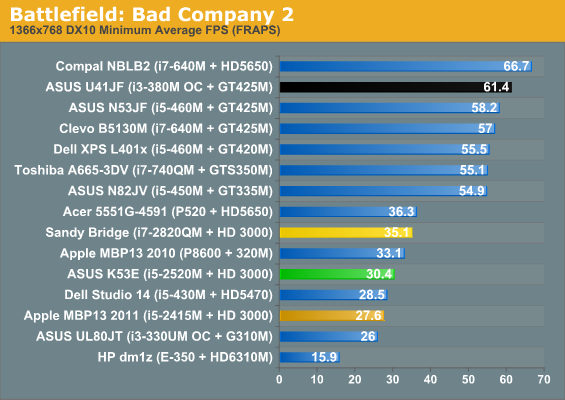
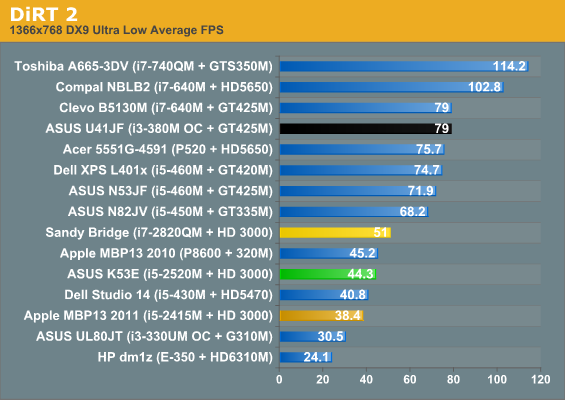
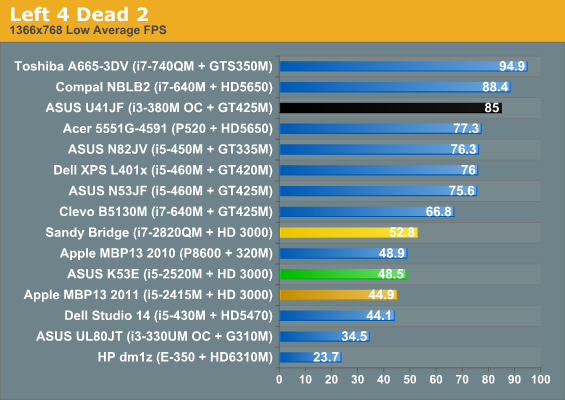
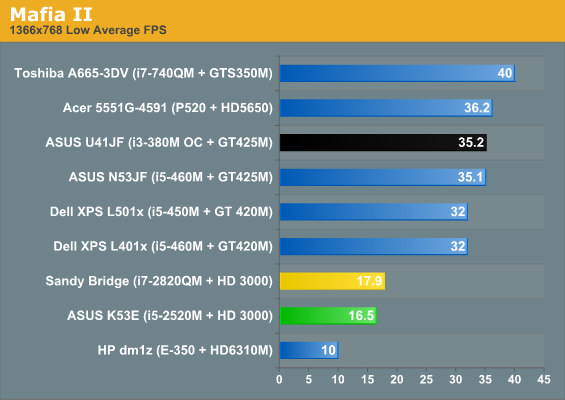
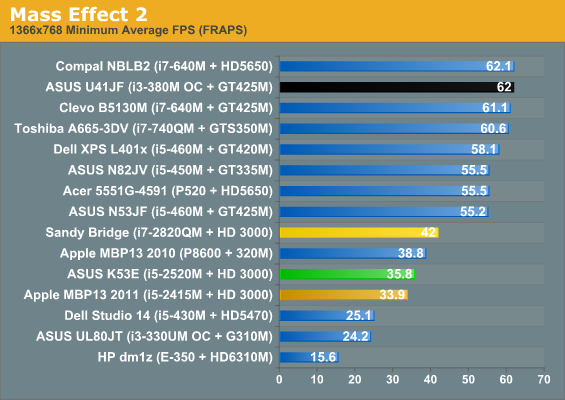
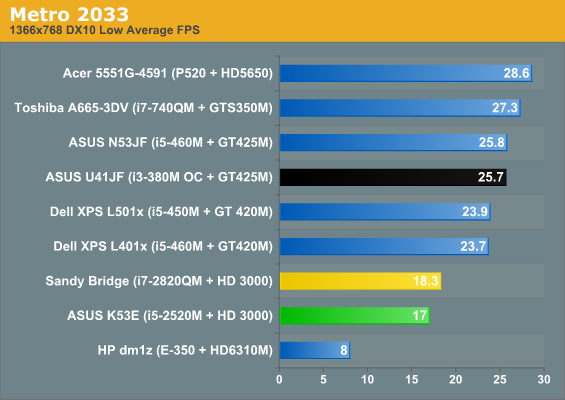
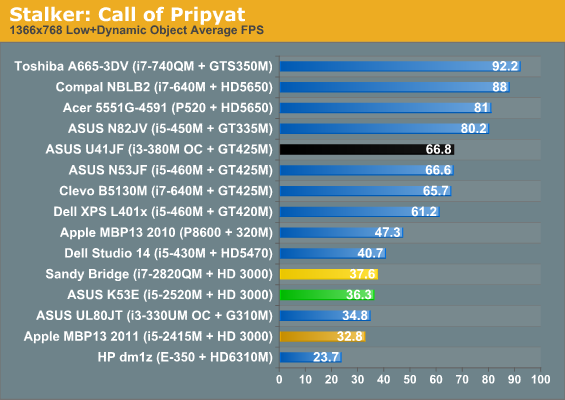
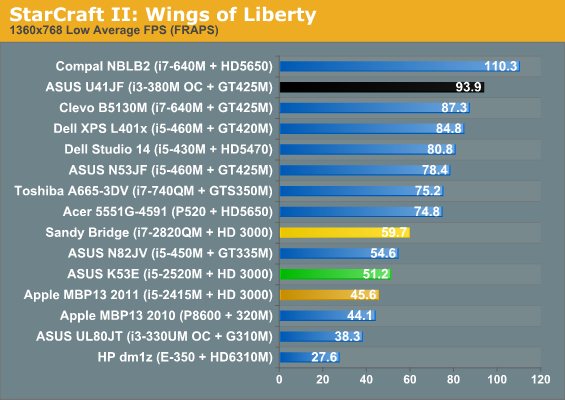
As we noted in the ASUS U41JF review, Intel’s relative standings in graphics are better with 3DMark than with actual games, particularly when we look at midrange GPUs like the GT 425M and HD 5650. Where the U41JF leads the K53E by 53% in the four 3DMark tests, in our eight actual games at low detail that increases to an 82% advantage. The K53E still leads the MBP13 2011 by 10%, and the i7-2820QM in turn leads the K53E by 12%—those results are the same as 3DMark, but then we’re dealing with the same IGP in all those cases. In terms of actual performance, the K53E breaks the 30FPS mark in six of the eight titles—Mafia II and Metro 2033 being the standard exceptions, but then those often fail to break 30FPS even on discrete GPUs.
What about the AMD E-350 comparison? As we just finished discussing, 3DMark shows the K53E coming in 125% faster than the E-350, though as we’ve noted in the past 3DMark can either skew things too much or too little towards CPU performance. Move over to our suite of games and the K53E still posts much higher scores than the E-350, but now the margin of victory is 88%. That’s still nearly twice the performance, and for a complete laptop you’re looking at around $725 versus $500 for similar components elsewhere. 45% more money for 88% faster graphics and 300% faster CPU performance isn’t a bad deal; what you don’t get with Sandy Bridge at that price is 8+ hours of battery life in an 11.6”-screen chassis.
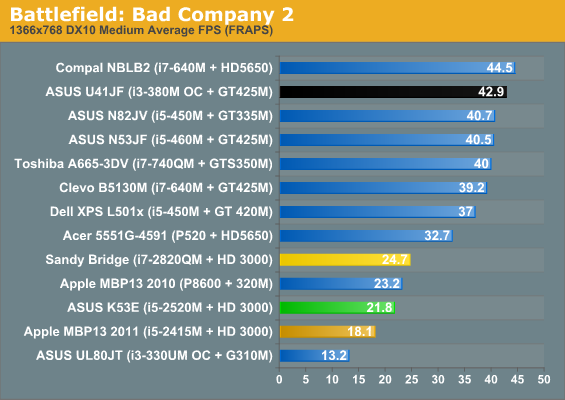


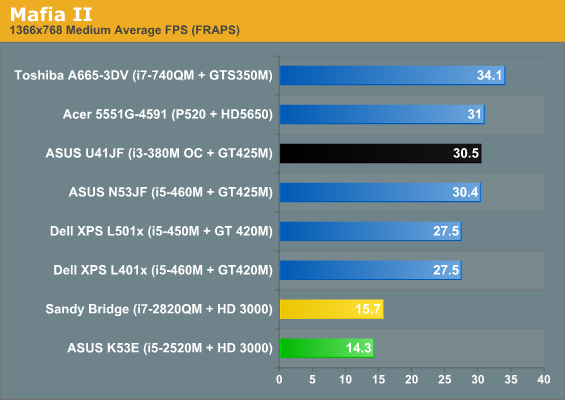

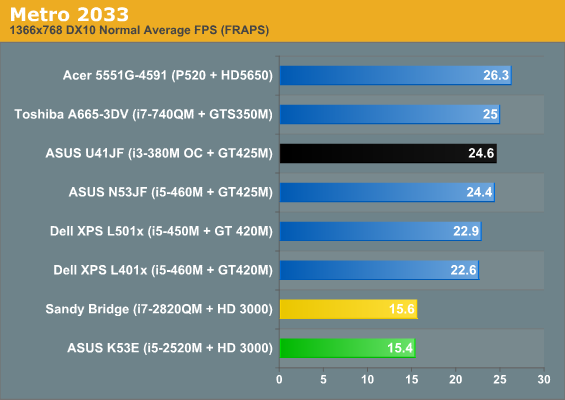
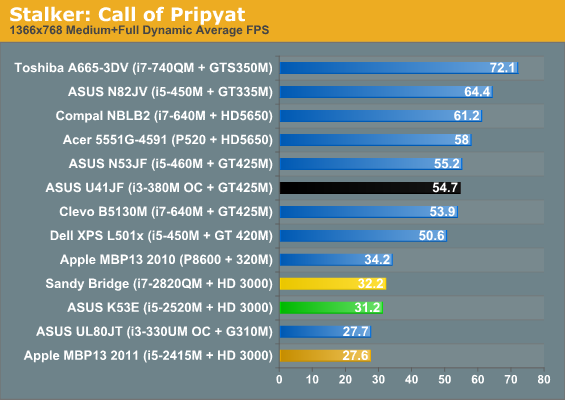
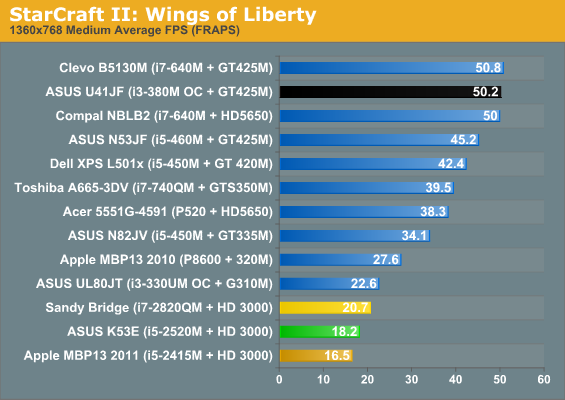
At medium detail settings, HD 3000 performance drops relative to the discrete GPUs. The K53E manages to hit 30FPS or higher in exactly one game this time: STALKER. It’s still 11% faster than the MBP13 2011, and the 2820QM is 14% faster than the K53E. Interesting to note is that the MBP13 2010 is also 15% faster than the K53, putting the GeForce 320M on the same level as the HD 3000 with quad-core CPU. By far the more pertinent piece of information is just how badly the U41JF trounces the K53E: Arrandale with a midrange dGPU comes out nearly 100% faster on average at our “Medium” settings, and it breaks 30FPS in every game in the list except Metro 2033.
For people looking to get an all-around laptop that can play games and provide adequate performance for general use, discrete GPUs are still required. Even then, midrange mobile GPUs are going to struggle with a lot of titles unless you turn down the detail settings and run at moderate (e.g. 720p) resolutions. On the other hand, if you’re not serious about gaming and graphics, Sandy Bridge’s IGP is very likely to satisfy the vast majority of users. Thankfully, it also manages to raise the bar relative to previous IGPs, with roughly double the performance of Arrandale’s HD Graphics and AMD’s HD 4250.
Rounding out the graphics discussion, other areas where the GPU helps also performed well. Viewing HD 1080p YouTube videos worked without any issues I could detect, thanks at least in part to the latest release of Adobe’s Flash player. Casual browser games like Bejeweled Blitz also worked fine, which isn’t something I could say on Arrandale where there was always a slightly perceptible delay—and that’s also a complaint I had with Brazos, which didn’t do well with Bejeweled Blitz. One interesting piece of information, however, is that the K53E really did poorly in Civilization V testing (not shown here, but you can see the scores in Mobile Bench), but whether that’s a driver problem or something else I can’t say.
Overall, gaming and graphics isn’t an absolute victory for Intel’s latest IGP, but it’s good enough for a large percentage of users. In the next month or so, we’ll see AMD’s counter to SNB with their second Fusion APU, Llano. That should provide at least double the GPU performance of Brazos, and even the aging K10.5 CPU core is a huge step up in performance from Bobcat. The combination should put Llano well ahead of HD 3000 in gaming, but whether it will be 50% faster or 100% faster we can't say for certain.
With a 32nm process technology and better use of power gating, Llano is going to be an interesting alternative, especially if the total system cost is similar to the $500 to $650 we’re seeing on current AMD notebooks. Sandy Bridge is unlikely to be touched for CPU computations by any of AMD’s mobile CPUs for the remainder of 2011, but with up to 400 Stream Processors Llano should come relatively close to the HD 6500 (HD 5600) series GPU performance. Put another way, while Intel’s HD 3000 is about twice the performance of Brazos’ IGP, Llano could easily double HD 3000. It’s a welcome change from the 15 to 25% improvements in IGP performance we often saw in previous platforms.










78 Comments
View All Comments
JarredWalton - Friday, April 8, 2011 - link
I spent almost half the conclusion talking about exactly this. I'm not sure what you want me to say more, other than you'd love for me to sing the praises of AMD and decry Intel has too expensive? Seriously:$300 to $500: Brazos C-50 or E-350 are hard to beat. If you want more performance with less battery life, Athlon/Turion/Phenom II are also available. Or wait a month for Llano and see how that compares.
Above $600, right now there's no way I would recommend Brazos. There's also no way I would recommend a 15.6" Brazos laptop, just like I would laugh at a 15.6" Atom-based system. Brazos E-350 is about twice the CPU performance of Atom, but then CULV was already three times as fast as Atom. I bashed on Atom a lot, and I continue to do so; it's far too easy to beat Atom and thus the real target has to be Pentium and Celeron at the very least. I'm going to see if I can get an Arrandale Pentium or Celeron just to see how it compares, because I expect about 2x the performance of Brazos on the CPU with slightly slower graphics. Well, actually a lot slower, but Bobcat is the bottleneck.
If anyone has $600 to spend on a laptop, they really shouldn't be looking at Brazos. Heck, even $500 is probably too much these days, considering all the options in that price range, unless you want small size and good battery life. If you can stomach the keyboard, Acer has the 1430Z (Pentium U5600) and the 1830T (i3-380UM) that are certainly viable alternatives to E-350.
krumme - Friday, April 8, 2011 - link
With a house full of Intel computers, i am not here to judge Intel as expensive and AMD as cheap. I think the consumers know what they should pay for the benefits if fthey get it presented in a balanced way. And i dont disagree with you recommandations personally.My point is. People can decides for themselves what is good enough for them. They are experts on their own life. If they buy a brazos and dont complain afterwards its fine for me. I have seen so many people getting disapointed by Atom for reasons we all know - no hd youtube and slow surfing. When someone less informed reads this review - perhaps by chance using google - and look at the bottom of the charts - they migt get the impression brazos is the same stuff as Atom. And judged by their standards - their measurements intruments - brazos is very different from Atom. So it would be a wrong assessment from their view.
And yes - right now the oem is ripping of brazos customers because of limited suply, - and because they can. But it just shows how brilliant the product is mm2 vs profitability. And yes AMD positioning this like pentium/celeron perf. is not just bs, but plain stupid for their long time brand building, as is the low performance parts eroding the brandvalue. But this is just AMD marketing performance as usual.
floersch - Friday, April 8, 2011 - link
Your General Performance charts identify the CPU of the Apple MBP13 2011 as an i5-2415M but your Gaming charts identify it as an i5-2515M. Are these two different machines or does one set of charts incorrectly identify the CPU?JarredWalton - Friday, April 8, 2011 - link
It's the 2415M... I'll correct the charts that have the wrong model number.floersch - Friday, April 8, 2011 - link
Thanks, Jarred, for the quick reply and for all of your excellent work. I always look forward to your analyses.vol7ron - Friday, April 8, 2011 - link
I think it's coming pretty close to a decent price point for performance.I'd like to see these laptops ship with a free HD extender/docker. It shouldn't cost the company much and when swapping out that big ol' 5400 for a SSD, it'd be nice to have the device immediately, to dedicate it to backups/storage.
What do you think?
veri745 - Friday, April 8, 2011 - link
Why drop the E-350 from the comparisons when you get to medium settings? I would expect it does a lot better relative to HD 3000 when you start bumping up the graphics settings.silverblue - Friday, April 8, 2011 - link
Not really, because HD 3000 will have access to much more bandwidth than Brazos.JarredWalton - Friday, April 8, 2011 - link
Because our medium settings typically run 25 to 50% slower than our low settings. Brazos manages to hit 30FPS in zero of the eight current games we're testing; do we need to show that it performs even worse at medium? Anyway, I actually did run MSI X370 at Medium settings. You can see the comparison (like many others) in Mobile Bench:http://www.anandtech.com/bench/Product/348?vs=346
silverblue - Friday, April 8, 2011 - link
Think about it... even if Brazos is supposed to be priced much lower than low-end Sandy Bridge laptops, it doesn't follow that it will always work out that way. You shouldn't ever be paying more than $500 for a Brazos machine unless it's a sufficiently high quality build but right now that doesn't seem to be the case all of the time.Toms just made a comparison between three diffferent Brazos laptops ( http://www.tomshardware.com/reviews/gateway-nv51b0... ) and they came to the conclusion that chopping $50 off the price of a lot of these machines could really make Brazos stand out.
What AMD should be doing is advertising Brazos as the true Atom competitor that it should be, at the very most CULV Celerons, instead of falsely positioning it as a competitor to Pentium setups.
Just because such articles highlight overcharging and the advantage of spending not a huge amount more on something far more powerful, that doesn't make it an incorrect assessment. I expect that once there's more Brazos offerings on the market, manufacturers will have to lower prices in order to compete, and then there really will be a gulf in price between Brazos and Sandy Bridge, like there should be.